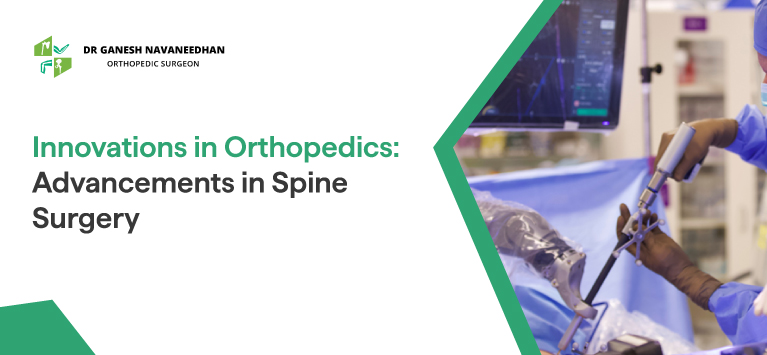- +91 62384 78716 +91 99475 78797
-
Sasthamangalam, Trivandrum
Sasthamangalam, Trivandrum

Orthopedics – The branch of dealing with musculoskeletal injuries and disorders is continuously evolving, with cutting-edge technologies and innovative treatments. Spine surgery, in particular, has seen significant advancements in recent years, revolutionizing the way we address spine-related conditions.
In this blog post, we have explained the latest innovations in orthopedics, focusing on the advancements in spine surgery and the potential benefits they offer to patients.
The integration of robotics and artificial intelligence has significantly enhanced spine surgery procedures.
Robotic-assisted spine surgery allows orthopedic surgeons to perform operations with higher accuracy and precision. This minimally invasive approach results in smaller incisions, less tissue damage, reduced postoperative pain, and faster recovery times for patients.
Additionally, AI algorithms analyze vast amounts of patient data, aiding in better treatment decisions and personalized care plans.This is realy one of the groundbreaking innovations in orthopedics.
Innovations in 3D printing technology have paved the way for personalized implants and prosthetics in spine surgery. With the use of bioprinting, living cells can be utilized to create complex tissues and structures, offering promising solutions for restoring damaged cartilage and bone.
These patient-specific implants fit more accurately, providing improved functionality and longer-lasting results.
Spine surgeons now benefit from augmented and virtual reality technologies for precise surgical planning and training. By interacting with 3D models of patients’ bones and joints, surgeons can optimize treatment strategies and further develop their surgical skills. By visualizing the patient’s anatomy in 3D, surgeons can identify the optimal pathways for accessing the affected area with minimal disruption to surrounding tissues. This not only reduces surgical trauma but also enhance surgical outcomes and improve patient safety.
Regenerative medicine holds great potential in spine surgery by harnessing the body’s natural healing mechanisms. Through the use of cells, tissues, and biomaterials, regenerative medicine promotes tissue repair and regeneration.
In tissue engineering, organs and tissues are grown in laboratories and transplanted into patients, providing a revolutionary approach to restore damaged bone and cartilage while reducing the need for traditional joint replacements.
Orthopedic medicine is embracing a range of non-surgical treatments for various musculoskeletal conditions.
Physical therapy, injections, and medications are viable alternatives for patients who may not require surgery. These non-invasive treatments not only improve patient outcomes but also reduce healthcare costs and recovery times.
In orthopedics, patient-centered care prioritizes the individual needs and preferences of patients. This approach empowers patients to be actively involved in their treatment decisions, providing them with information and tools like OrthoMind, Physitrack to manage their conditions effectively. By addressing emotional and social needs alongside physical health, patient-centered care leads to better overall outcomes and patient satisfaction.
The advancement of telemedicine and wearable technology has transformed how orthopedic patients receive care. Remote video consultations and monitoring enable patients to access treatment from the comfort of their homes. Wearable devices track progress during rehabilitation, provide personalized coaching, and offer continuous support for post-surgical recovery, including joint replacements.
The future of orthopedic surgical procedures, such as spine surgery is filled with promise and potential, thanks to the advancements like robotics, AI, 3D printing, and regenerative medicine, Besides enhancing the accessibility and effectiveness of orthopedic treatments, they are transforming patient care and outcomes.
As we move forward, addressing ethical, cost-related, and collaborative challenges will be vital in maximizing the benefits of these innovations in orthopedics.
As patients and healthcare practitioners, staying informed about these innovations in orthopedics and engaging in collaborative discussions will shape the future of orthopedic care and pave the way for even more significant advancements.
Copyright © 2025 Dr. Ganesh Navaneedhan. All Rights Reserved. | Designed By Harvee healthcare